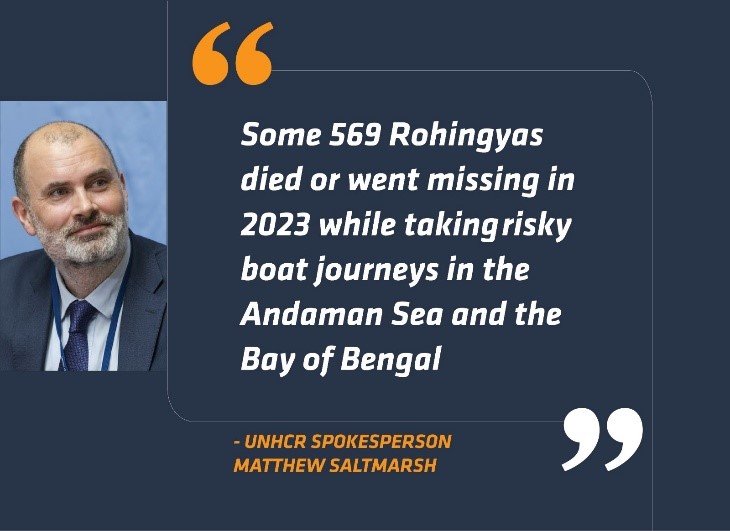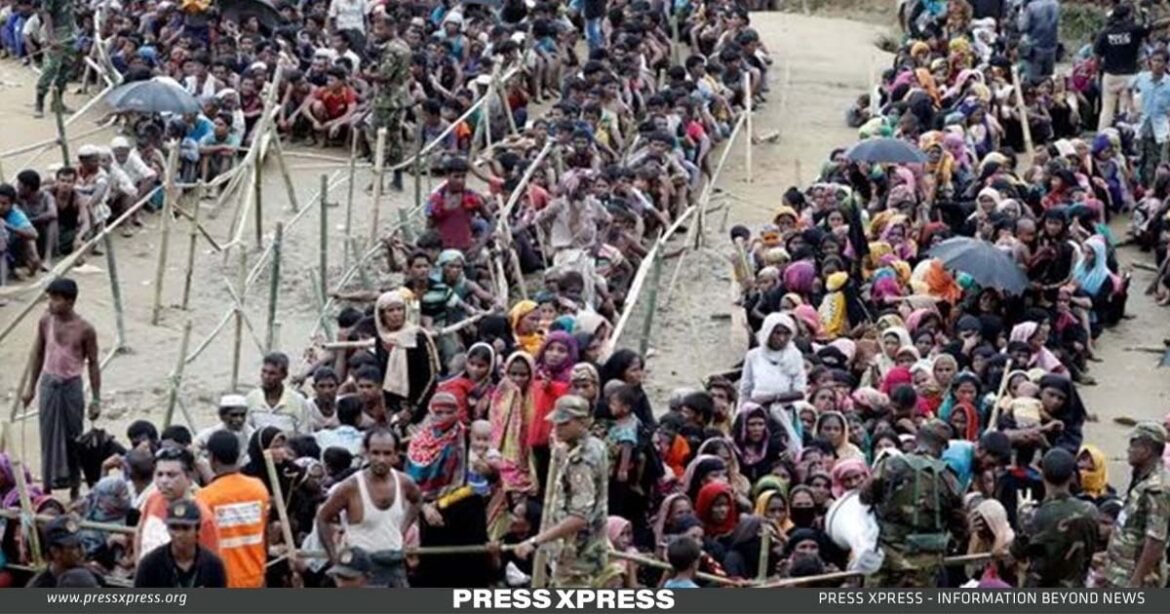Key highlights:
- Over 12.5 lakh Rohingya refugees in 33 shelter camps in Ukhia and Teknaf
- Govt spends over $1 billion every year for Rohingyas
- Two repatriation initiatives in 2019 failed as Rohingyas could not trust Myanmar’s promises
- The WFP cut per capita monthly food aid from $12 to $8 in 2023
On August 25, 2017, hundreds and thousands of Rohingyas from the Rakhine State of Myanmar started fleeing the country in the face of a brutal army crackdown that reportedly killed more than 24,000 Rohingyas within a few months, triggering a mass exodus. In a matter of months, 800,000 Rohingya, a Muslim minority in a predominantly Buddhist nation, sought refuge in Ukhia and Teknaf upazilas in Cox’s Bazar, joining the 400,000 already residing in refugee camps.
Currently, over 1.25 million registered Rohingyas in 33 camps in Ukhia and Teknaf have been awaiting repatriation for over six years, despite frequent international discussions on the matter.
You can also read: Houthi Anger Escalates: UN Staff with US and UK Nationality Expelled
Meanwhile, in addition to spending on humanitarian activities, Bangladesh is spending a lot of manpower and money on managing the Rohingya community. Bangladesh government has to spend more than $1 billion every year for Rohingyas. The economic, security, social, and environmental costs of the Rohingya crisis are mounting day by day. Out of a total of 20,92,016 acres of forest land in Cox’s Bazar, 3,500 acres have already been lost due to the Rohingya population.
UN stresses voluntary Rohingya repatriation
The United Nations has stated that no Rohingya refugee should be repatriated against their will.
On January 23, Stephane Dujarric, spokesperson for the UN secretary-general, told reporters at a regular media briefing in New York, “Repatriation needs to be done voluntarily and in a manner that preserves their dignity and their safety. It is clear to us that the situation in Myanmar currently does not meet the requirements.”
He called for solidarity and increased funding for the Rohingyas and their host communities in Cox’s Bazar.

Rohingyas agree to safe repatriation
According to media reports, Rohingya leaders have said that any attempt to forcibly repatriate any Rohingya could backfire. A suitable living environment must be ensured in Rakhine. Rohingyas should be assured that they will not be subjected to persecution in the future, and will not have to flee to Bangladesh again. UNHCR also needs to be involved in repatriation.
The United States also is not interested in forced repatriation. After visiting the refugee camps in Cox’s Bazar, US Assistant Secretary of State for South and Central Asia Afrin Akhtar told reporters that voluntary repatriation is only possible after creating a favorable environment in Myanmar.
“The US does not want the repatriation of the Rohingyas by force. The US is working toward safe and sustainable repatriation,” she said.

Number of refugees increasing due to birth
Every year 33,000 Rohingya children are born in refugee camps of 12.5 million Rohingyas. Nearly two lakh children were born in the last six years.
As the repatriation is being delayed year after year, the youths in refugee camps are getting involved in drug smuggling and terrorism, which is ominous for the country and a threat to security.
Initiatives for repatriation
In the face of international pressure, Myanmar’s Aung San Suu Kyi government agreed to take back the Rohingyas at the end of 2017. It also signed a bilateral agreement with Bangladesh in September that year. In 2019, repatriation initiative was twice. But the initiatives failed because the Rohingyas could not trust the Myanmar government’s promises.
In February 2021, General Min Aung Hlaing seized power in Myanmar by removing Suu Kyi’s government which dealt a severe blow to the repatriation process
Then came the coronavirus pandemic, the attention of the international community shifted from the Rohingya issue. Amid the global pandemic, in February 2021, General Min Aung Hlaing seized power by removing Suu Kyi’s government which dealt a severe blow to the repatriation process.
In May 2023, a Rohingya delegation of 20 people from the Cox’s Bazar refugee camp visited Rakhine State to see if the situation was suitable for repatriation. They were taken to Maungdaw city where the Myanmar government has built a ‘Model Village’ near the city to keep the Rohingyas in shelter camps. But the Rohingyas refused to stay in the ‘Model Village’, rather they want to return to their abandoned ancestral homes. Myanmar has now agreed to resettle Rohingyas in abandoned settlements.
Situation at the camps
The Rohingya refugee camps are becoming unstable day by day due to various reasons. There are constant incidents of murders, human trafficking, drug and arms smuggling, disappearances, kidnappings and ransom demands and arson.
Some 2,438 cases have been filed over different types of crimes including weapons, drugs, rape, kidnapping, robbery, murder and human trafficking in Rohingya camps. From August 25, 2017 to June 2023, 164 murders have taken place in Rohingya camps where, currently, more than 70,000 Rohingyas live per square kilometer.
Rohingyas desperate to leave camps
Some of the Rohingyas are embarking on deadly boat journeys in desperate attempt to leave the camps in search of a better life in Australia, Malaysia, Thailand or Indonesia.
The United Nations High Commissioner for Refugees (UNHCR) has expressed concern over the alarming rise in the number of Rohingya refugees who reportedly died or went missing in 2023 while taking risky boat journeys in the Andaman Sea and the Bay of Bengal during 2023.
On January 24, at a press briefing held at the Palais des Nations in Geneva, UNHCR spokesperson Matthew Saltmarsh revealed that 569 Rohingyas were reported to have perished or gone missing last year in South-East Asian waters, with nearly 4,500 embarking on deadly sea journeys – a significant increase from previous years.
“The total reported dead or missing in 2023 was over 200 more than in 2022. Survivors have shared horrifying accounts of abuse and exploitation during the journey, including gender-based violence,” he said.

UN reduces food aid to Rohingya refugees
The World Food Program (WFP) cut food aid to the Rohingya by about 33% as donors cut grants due to the global economic downturn and crisis. The per capita monthly allocation for food to the Rohingya was $12 which was reduced to $10 from March 1, 2023.
Later from June 1 of the same year, it was further reduced to $8. As a result, aid workers fear that the food crisis in the Rohingya camps will worsen and the security situation in the camps may deteriorate.
Seeking $1.25 billion in emergency funding from international donor groups, the WFP said that a third of the camps’ residents are children, with many of them underweight and stunted by malnutrition. In this situation, if they do not get emergency funding for food, the impact will be wide and far-reaching, warned the WFP.
Conclusion
Several steps can be taken in the coming days to solve the Rohingya crisis. As the problem remains unresolved for more than six years from 2017 to 2023, a long-term plan must be developed to address the crisis. In order to keep the relief and financial aid going, measures should be taken on an urgent basis to build up reserves.
To play an active role in dealing with this long-term problem, the government has to form a team or a commission at the national level. The commission will undertake and implement effective steps for a safe, dignified and sustainable repatriation of the Rohingya community in stages. Besides, it can also play a significant role in monitoring other related activities and highlight them in regional and international forums to solve the crisis.
It is about time the international community exert pressure on the Myanmar government to enact policies that grant full citizenship and equal rights to the Rohingya community. The Rohingya must also be assured that upon return, they will enjoy the same rights and privileges as other citizens of Myanmar.


